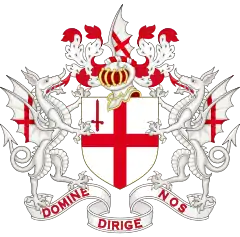John Williams (died 1743)
Sir John Williams (c. 1675–7 May 1743) was an English merchant and Tory politician who sat in the House of Commons from 1730 to 1734. He was Lord Mayor of London for the year 1735 to 1736.
Williams was the second son of Reginald Williams of Stoke by Nayland, and his second wife Sarah Dyke, daughter of Sir Thomas Dyke of Horsham, Sussex. He was a merchant in trade with Turkey and was said to be ‘the greatest exporter of cloth in England. He married by licence dated 8 March 1709, Mary Onslow, daughter of Richard Onslow, 1st Baron Onslow, Speaker of the House of Commons.[1]
Williams was a Director of the South Sea Company from 1711 to 1715. In 1720 he was sub-governor of the Royal Exchange Assurance 1720. He was elected Alderman for Cripplegate on 20 June 1723 and was knighted on 23 June 1723. He also became Master of the Mercers Company in 1723. [2] He stood for parliament at Minehead in a by-election in 1723, but was unsuccessful. At the 1727 British general election, he contested City of London and was again unsuccessful.[1] He was Sheriff of London for the year 1729 to 1730.
Williams was returned as Tory MP for Aldeburgh at a by-election on 8 May 1730. He did not stand in 1734. He served as Lord Mayor for the year 1735 to 1736.[1]
Williams died on 7 May 1743 after languishing of a dropsy and had been tapped several times. He left three sons.[1]
References
- "WILLIAMS, Sir John (167?-1743), of Stoke by Nayland, Suff". History of Parliament Online. Retrieved 11 February 2019.
- Alfred P Beaven. "'Chronological list of aldermen: 1701-1800', in The Aldermen of the City of London Temp. Henry III - 1912 (London, 1908), pp. 119-140". British History Online. Retrieved 14 December 2018.
| Parliament of Great Britain | ||
|---|---|---|
| Preceded by William Windham Samuel Lowe |
Aldeburgh (UK Parliament constituency) 1730–1734 With: Samuel Lowe Captain George Purvis 1732-1734 |
Succeeded by William Conolly Captain George Purvis |
| Civic offices | ||
| Preceded by Sir Edward Bellamy |
 1735– 1736 |
Succeeded by Sir John Thompson |